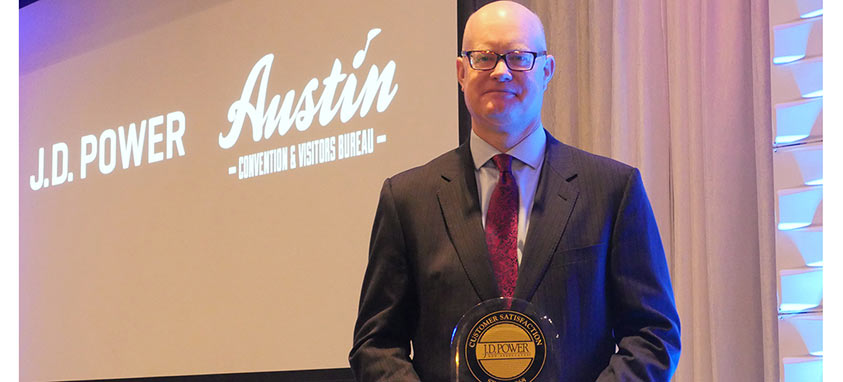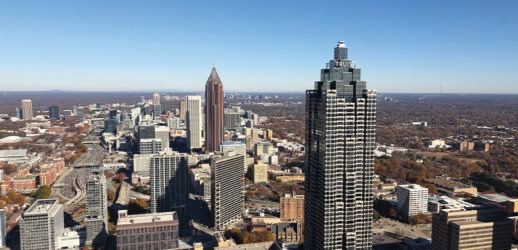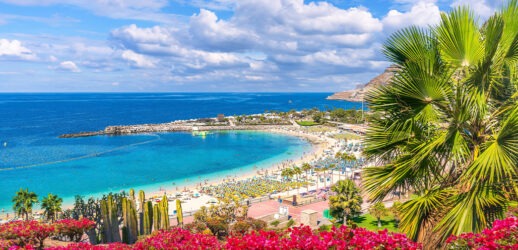Tom Noonan, president and CEO of Austin Convention & Visitors Bureau, accepted the J.D. Power and Associates 2016 Destination Experience Satisfaction Award.
When visitors enjoy their travel experience in a particular city, they spend considerably more during their stay than the average traveler, according to the J.D. Power 2016 Destination Experience Satisfaction Study released this week.
The first-of-its-kind study measures overall satisfaction among visitors to the top 50 U.S. travel destinations for business or leisure. It assesses the customer experience based on six factors: activities, cost and fees, food and beverage, infrastructure, lodging and travel. The study is based on more than 26,000 travelers who visited a U.S. metropolitan area between December 2015 and July 2016. Participants were asked to rate their experience on a scale of one to 10.
On average, visitors spend $1,169 on a trip, or $301 per day, according to the study. Those who are especially delighted with their experience (rating their overall satisfaction a 10 out of 10) spend, on average, $1,446, or 24 percent more than average. Those who are either indifferent (6 or 7) or disappointed (5 or lower) spend nearly $250 less per trip than average—a full 37 percent difference in spending between the categories of delighted and disappointed.
“Interestingly, while visitors spend more when they have a great experience, they’re also more satisfied with the value they receive for their expenditure,” said Rick Garlick, global travel and hospitality practice lead at J.D. Power. “Especially for cities that are perhaps less thought of for tourism, the investment in creating a superb visitor experience can really pay off.”
Destination Experience Rankings
While the top-ranked cities include well-known destinations, two of the leading regional destinations are state capitals or college towns known for music and football rather than being well-known travel hubs. At the segment level, the south and southwest regions tie for the highest average score, at 802 points each on a 1,000-point scale. They are followed closely by the west region with a score of 801.
-West Region: Las Vegas claims to have it all, and maybe the city is right. It ranks highest in the region and earns the study’s highest index score of 827. Las Vegas performs particularly well in four of the six factors: travel, lodging, infrastructure, and cost and fees. Las Vegas is followed in the regional rankings by Oahu Island, Hawaii, with a score of 813 and San Diego with 812.
-Southwest Region:Austin, the Texas capital and home to University of Texas and a myriad of music venues, ranks highest with a score of 818, followed by Dallas with 811 and San Antonio, Texas, with 807. Austin performs particularly well with infrastructure and activities.
-South Region: Orlando, Florida, noted for family-oriented theme parks, ranks highest in the region with a score of 815 points, followed by Miami and New Orleans in a tie at 814. Orlando performs particularly well with infrastructure and activities. The south is the most competitive in the study, with only 27 points separating the highest- and lowest-ranked destinations in the region.
-Northeast/Mid-Atlantic Region: New York, the city that never sleeps, ranks highest with a score of 805, followed by Boston with 789. New York performs particularly well in four of the six factors: travel; lodging; food and beverage; and activities.
-Midwest Region: Columbus, the state capital of Ohio and home of Ohio State University, ranks highest with a score of 799, followed by Kansas City with 791 and Indianapolis with 789. Columbus performs particularly well in the infrastructure, food and beverage, and cost and fees.
Additional Key Findings
-More than a Destination: Visitors often view cities as more than just a place to visit; they develop a strong emotional connection. Cities with a high percentage of visitors feeling a strong emotional attachment include Austin, Oahu Island, Orlando, Miami and San Diego.
-Loving the City You Visit: Despite the great weather offered in other regions, the Northeast/Mid-Atlantic region has the highest proportion of visitors who are most likely to return (73 percent) and recommend their destinations to others (65 percent). The west, however, contains cities such as Anaheim, Denver and San Diego, to which people have the fondest emotional attachment, with 39 percent admitting they would be greatly disappointed if they could not return.
-Food, Fun and Lodging: Three things travelers often consider when selecting a place to visit are things to do, food options and places to stay. The study finds Las Vegas and New Orleans are the two cities that are among the top five for all three: lodging, food and beverage and entertainment, which includes options such as shopping, nightlife, zoos, aquariums and gaming. Orlando is among the top five cities for lodging and entertainment, and Oahu Island is among the leaders for food and beverage and entertainment.
-Traditional Travel Agents Garner Better Experiences: While 28 percent of visitors used an independent travel website to book their trip, satisfaction with their destination ranked significantly higher among those who used a traditional travel agent (805 vs. 845, respectively). However, most travel continues to be booked online, with only 7 percent of visitors having used a travel agent to book their trip.
-Business Travelers More Satisfied Than Vacationers: Those who travel to a destination for business purposes enjoy their trip slightly more than those who travel for leisure (806 vs. 795, respectively). Satisfaction with cost and fees plays a role, as business travelers frequently have their trip paid for by their employer. Satisfaction in the travel factor is also higher among business travelers than among leisure travelers, perhaps because they’ve learned to adapt to the travel process much better than less experienced travelers.




